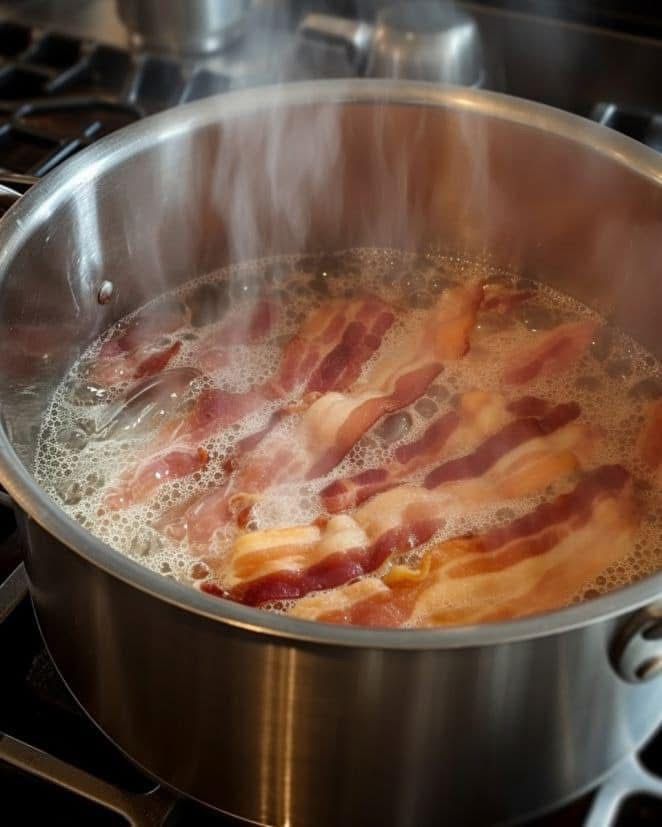Boiled Bacon Method: A Unique and Delicious Take on a Classic Favorite

Introduction:
Boiling bacon may sound unusual at first, especially in a world where crispy pan-fried bacon dominates breakfast tables. But this old-school cooking method has deep roots and offers a surprising array of benefits — from a more tender bite to a milder flavor, and even health advantages. This technique gently renders the fat, softens the meat, and creates a juicy, savory result that can be enjoyed in countless dishes.
Let’s dive into this comforting, old-fashioned, yet versatile approach to preparing bacon with full instructions, methods, history, benefits, and more.
Ingredients:
- 1 pound (450 g) thick-cut bacon (uncured or cured)
- Enough water to cover the bacon in the pot
- Optional aromatics:
- 1 bay leaf
- 4–5 whole peppercorns
- 1 garlic clove, smashed
- 1 small onion, halved
Instructions:
- Place the bacon in a wide saucepan in a single layer.
- Add cold water until the bacon is just submerged.
- Optional: Add aromatics for extra depth of flavor.
- Place the pot over medium heat and bring to a gentle boil.
- Once boiling, reduce to a simmer and cook uncovered for 30–45 minutes, depending on thickness.
- Check occasionally to remove scum and impurities that rise to the surface.
- When bacon is tender, drain it and optionally crisp in a skillet or under a broiler for a contrast in texture.
- Slice and serve — in sandwiches, with cabbage, or as part of a breakfast platter.
Method:
- Boiling bacon slowly renders the fat without burning, while keeping the meat moist and tender.
- Simmering preserves the integrity of the meat while infusing it with subtle flavors from the water and added aromatics.
History:
Boiling bacon has historical roots in Irish, British, and early American cuisine. Before refrigeration, pork was preserved through curing and then cooked via boiling, which helped remove excess salt and soften the tough cured meat. It was often served with cabbage, root vegetables, or bread.
In rural areas, a boiled bacon joint was a cherished staple — simple, hearty, and economical.
Benefits:
- Healthier – Much of the fat renders out into the water, lowering calorie and fat content.
- More tender – Perfect for dishes like bacon sandwiches, breakfast casseroles, or bacon salads.
- Less smoky and greasy – Ideal for people who prefer milder bacon flavors.
- Versatile – Pre-cooked bacon can be sliced, seared, or used in recipes like quiche or carbonara.
Formation:
You can form dishes around boiled bacon:
- Irish Boiled Bacon and Cabbage
- Boiled Bacon and Parsley Sauce
- Boiled Bacon Sandwiches with Mustard
- Boiled Bacon and Potato Hash
Conclusion:
Boiled bacon may not be the trendiest technique, but it’s steeped in tradition and flavor. Whether you’re looking for a less greasy option, or you want bacon that melts in your mouth, this is the method to try. It’s a comforting, budget-friendly way to prepare this beloved meat and introduce something nostalgic and delicious to your kitchen.
For the Lovers of Bacon:
If you love bacon in all its forms, don’t overlook boiling. It’s a hidden gem in the culinary world, especially when paired with earthy veggies or hearty grains. For bacon lovers who care about both taste and texture, boiled bacon offers a soulful, juicy experience unlike any other.
Nutrition (Per 2 Slices, Boiled):
| Nutrient | Amount |
|---|---|
| Calories | 100–120 kcal |
| Protein | 6–8 g |
| Total Fat | 7–9 g |
| Saturated Fat | 2.5–3.5 g |
| Sodium | 400–600 mg |
| Carbs | 0 g |
Note: Boiling can reduce sodium and fat content by ~25% compared to frying.
Final Conclusion with Love:
Boiled bacon is a heartwarming, old-fashioned approach that deserves more attention. Whether you’re rediscovering this technique from your grandma’s kitchen or experimenting for the first time, you’ll find yourself falling for the soft, rich texture and comforting simplicity of boiled bacon. Give it a try — and fall in love with bacon all over again.